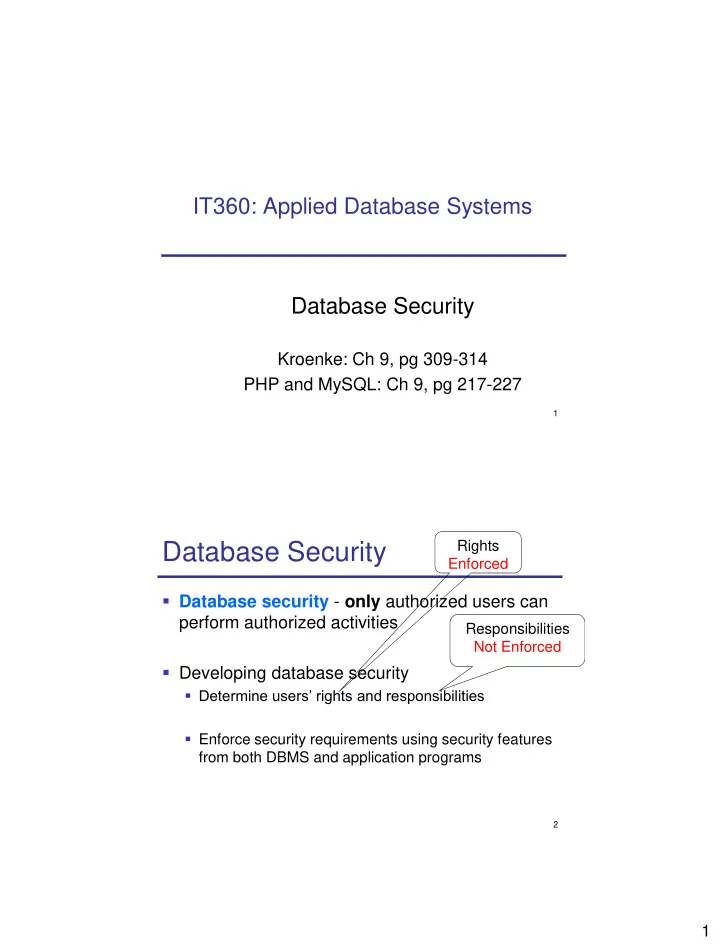

IT360: Applied Database Systems Database Security Kroenke: Ch 9, pg 309-314 PHP and MySQL: Ch 9, pg 217-227 1 Rights Database Security Enforced Database security - only authorized users can perform authorized activities Responsibilities Not Enforced Developing database security Determine users’ rights and responsibilities Enforce security requirements using security features from both DBMS and application programs 2 1
DBMS Security DBMS products provide security facilities They limit certain actions on certain objects to certain users or groups (also called roles ) Almost all DBMS products use some form of user name and password security Examples? 3 Principle of Least Privilege Privileges “A user (or process) should have the lowest level of privilege required to perform his assigned task” 4 2
GRANT and REVOKE GRANT – create users / grant them privileges REVOKE – remove privileges Privileges: ALL SELECT INSERT, DELETE, UPDATE CREATE, ALTER, DROP USAGE //no privileges 5 GRANT Syntax GRANT privileges [columns] ON object TO user [IDENTIFIED BY ' password '] [WITH GRANT OPTION] Example: GRANT ALL ON dbmusic.* TO dbuser IDENTIFIED BY ‘userpass’ 6 3
REVOKE Syntax REVOKE priv_type ON object FROM user [, user ] Example: REVOKE INSERT ON dbmusic.* FROM dbuser 7 Changing the Password – Option 1 mysql database, user table, password column UPDATE user SET Password = PASSWORD(‘newpass’) WHERE User = ‘dbuser’; [flush privileges;] 8 4
Changing the Password – Option 2 SET PASSWORD [FOR ‘ username’@’host’] = PASSWORD(' newpass '); Example: While logged in as dbuser SET PASSWORD = PASSWORD(‘it360’) 9 DBMS Security Guidelines Run DBMS behind a firewall, but plan as though the firewall has been breached Apply the latest operating system and DBMS service packs and fixes Use the least functionality possible Protect the computer that runs the DBMS 10 5
DBMS Security Guidelines Manage accounts and passwords Use a low privilege user account for the DBMS service Protect database accounts with strong passwords Monitor failed login attempts Frequently check group and role memberships Audit accounts with null passwords Assign accounts the lowest privileges possible Limit DBA account privileges Planning Develop a security plan for preventing and detecting security problems Create procedures for security emergencies and practice them 11 Application Security If DBMS security features are inadequate, additional security code could be written in application program Example? Use the DBMS security features first 12 6
Application Users Enforce strong passwords Never store passwords in plain text 13 SQL Injection Attacks! SQL injection attack occurs when data from the user is used to modify a SQL statement Example: users are asked to enter their alpha into a Web form textbox User input: 131234 OR TRUE SELECT * FROM STUDENT_GRADES WHERE Alpha = 131234 OR TRUE; Result? 14 7
Making your MySQL Database Secure - Server Do not run MySQL (mysqld) as root! Set up a user just for running the server Make directories accessible just to this user Run MySQL server behind a firewall 15 Making your MySQL Database Secure - Passwods Make sure all users have strong passwords Connecting from PHP: Have the user and password stored in a file myConnectDB.inc.php and include this file when required Store myConnectDB.inc.php outside web tree ($_SERVER[‘DOCUMENT_ROOT’]) Store passwords only in .php files (not .inc,.txt, etc.) Do not store application passwords in plain text. Use sha1() or other hashing method. 16 8
Making your MySQL Database Secure – User Privileges Use principle of least privilege: Grant only the privileges actually needed to each user Grand access only from the host(s) that they will be connecting from 17 Making your MySQL Database Secure – Web Issues Set up a special user just for web connections, with minimum required privileges Check all data coming from user (SQL Injection Attacks!!) addslashes() / stripslashes() doubleval() 18 9
Recommend
More recommend